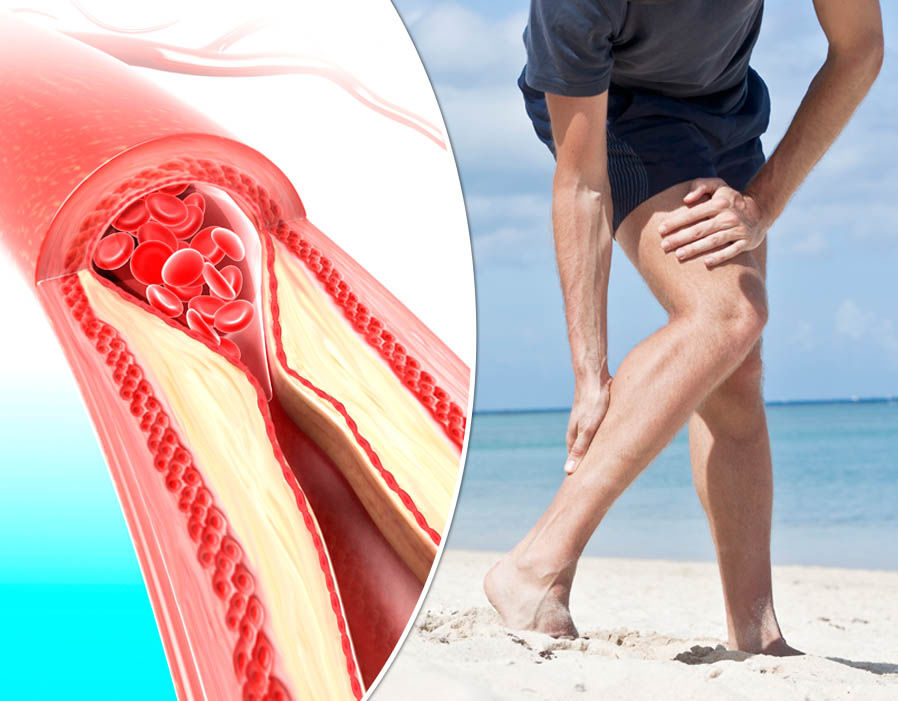OVERVIEW
Peripheral artery disease which is also called as a peripheral arterial disease is a common circulatory problem where the blood flow to the limbs is reduced due to narrowed arteries. When one develops peripheral artery disease (PAD) the lower extremities of the body such as legs don’t receive enough blood flow. This leads to leg pain while walking. It also could be a sign of widespread accumulation of fatty deposits in the arteries. In this condition, even the blood flow to the heart and brain is reduced. However, peripheral artery disease can be successfully treated if one quits tobacco, regularly exercises, and also maintains a healthy diet.
Peripheral artery disease or PAD is a variant of peripheral vascular disease (PVD) which is generally known to occur only in the arteries. Building up of fatty material which is a gradual process inside the vessels where the arteries harden is what causes the condition. And over a long time period, the arteries gets blocked, narrowed and also weakened.
It usually occurs in people who are above the age of 60 and affects around 12% to 20% of people in this age group. It is also found to be common among people who suffer from diabetes and it is the men who are more affected than women. The condition is also found in people who are heavy smokers. PVD is also found to be the leading cause of disability among people who are above the age of 60 and also those who have diabetes. Around 50% of the people with the peripheral vascular disease don’t experience any symptoms. However, those who have symptoms end up ignoring their condition and do not consult a doctor, assuming it to be normal and a part of the aging process. One should be aware that surgery is one of the most effective treatments available for the peripheral vascular disease, and treating PVD medically and also with few lifestyle modifications can prevent it from getting worse and further protect the person affected by it against complications.
Symptoms of peripheral artery disease:

Most of the individuals, about 60% of them who suffer from peripheral artery disease have shown some symptoms of it. The most common of all is the symptom caused by the leg muscles which do not get enough blood. If one has PAD, the most common symptom is the pain in the leg that comes and goes and is especially found in both calves and hips. The pain is severe while walking or climbing stairs, but this usually stops when at rest. A dull and cramping pain is often the complaint but it can at times feel like tightness, heaviness or fatigue in the legs.
Other symptoms include:
- Weakness or Numbness in the Legs
- Atrial septal defect
- Coldness in the lower leg or foot
- Sores on feet, toes or legs that take a long time to heal or won’t heal
- Change in the color of legs
- Loss of hair or slower hair growth on legs and feet
- Pain the buttocks
- Aching or burning pain in the feet or toes while taking rest
Causes of peripheral artery disease
Atherosclerosis in the peripheral arteries is the most common reason for one to develop PAD. Atherosclerosis is characterized as the hardening of the arteries which is a gradual process where the cholesterol plaque material builds up and there is inflammation in the inner walls of the arteries. Over a time period, the cholesterol plaque starts building over and will block, weaken and narrow the blood vessel walls. The final outcome of this is blocked or restricted blood flow.
Other causes
- Diabetes: The high level of sugar in diabetic patients can damage their blood vessels in a period of time. This tends to make their blood vessels narrower and weakened. And there are also chances of people with diabetes having high blood pressure and high fats in the blood that further leads to the development of atherosclerosis.
- Inflammation of Arteries: Also known as arthritis, it can also cause weakening and narrowing of the arteries. There are various autoimmune conditions that can cause vacuities and besides arteries, it can affect other organ systems too.
- Injury due to the accident: An accident or a bad fall can also cause the blood vessels to be injured.
- Infection: Scarring or inflammation that is caused by certain infections can also narrow or weaken blood vessels. Salmonellosis, the infection that is caused by salmonella bacteria and syphilis are two infections that are known to infect and damage blood vessels.
Risk Factors of peripheral artery disease
- Older than 50 years
- Having a family history of heart disease.
- High blood pressure
- Diabetes
- Having a family history of high blood pressure and high cholesterol
- Sedentary lifestyle
- Overweight
- Thoracic surgery
- Have kidney disease.
Diagnosis of peripheral artery disease
It is important to see a doctor if one suspects to have PVD as early diagnosis and suitable treatment can always help prevent various future complications from occurring and improve the outlook.
A doctor will diagnose the PVD by considering a full medical and family history which includes details such as your lifestyle, diet, and use of medication if any. Certain physical examinations will also be performed by the doctor including checking the skin appearance, temperature and also the presence of pulses in legs and feet. Some tests will also be advised to confirm a diagnosis or rule out other conditions as there are various other disorders that could mimic the same symptoms of PVD.
Diagnostic tests that are used to diagnose PVD include:
- Blood Tests: You may be asked to take blood tests by the doctor to diagnose peripheral artery disease. However, blood tests alone may not diagnose the condition but can help the doctor check the presence of conditions like diabetes and cholesterol that could increase a person’s risk of developing PAD.
- Computerized tomography angiography (CTA): A CTA imaging test helps the doctor by showing the image of the blood vessels that include those areas that have become narrow or are blocked.
- Ultrasound: An ultrasound scan basically is a painless procedure. It uses high-frequency sound waves and the signals and images produced by it are particularly used by doctors to evaluate arterial blood flow.
- Angiography is a type of X-ray and basically has been used for many years in diagnostics for many heart-related conditions. It is considered to be the best diagnostic test available. It has also been used to guide further surgery and treatment. But the preference is more for ultrasound and MRI, as they are less invasive and work just as well. During angiography, a dye gets injected into the arteries so that it highlights blocking and narrowing of the arteries.
Ankle-brachial Index: This is a non-invasive test that is helpful in measuring blood pressure in the ankles. Once the blood pressure is measured in the ankles then the doctor compares the reading with that of readings in the arms. There are basically two measurements taken by the doctor one after rest and another after any physical activity. If the doctor finds any low blood pressure in the legs it suggests a blockage.
TREATMENT
The overall treatment for a peripheral artery disease totally depends upon the underlying cause of the disease, and the severity of the condition. Although there are several ways to reduce the risk factors of atrial tachycardia, not all risk factors can be changed but most of them can be reduced.
- Maintain a healthy weight and eating a nutritious diet that is low in fats and also avoiding foods that are high in cholesterol.
- Be more active: By being active and doing regular exercise, such as walking can often bring down the symptoms and also increase the distance you can walk without any symptoms.
- Stop Smoking: Quitting smoking helps in reducing the symptoms and also brings down the chance of making the PVD worse.
Angioplasty: For this procedure, a small hollow tube is inserted through a blood vessel to the affected artery and a balloon placed on the tip of this catheter is inflated so that the artery is reopened. This would also flatten the blockage in the artery and stretch the artery open to increase the blood flow. The doctor may also insert a stent in the patient’s artery so that it can be kept open for continuous blood flow.
Bypass surgery: A graft bypass is created by the doctor by using a vessel from another part of the body or a blood vessel made of synthetic fabric. With this technique, the blood easily flows around or bypasses the narrowed or blocked artery.
Medications
Although certain lifestyle changes might make can be good enough for treating peripheral artery disease in some people, there are others who may require medical attention. There are several medications that are used to treat peripheral artery disease, which includes, anti-clotting agents, medications that are used to increase blood supply, cholesterol-lowering drugs and medications that help control high blood pressure.
Prevention of peripheral artery disease
If there is a way to prevent peripheral vascular disease, it is to reduce your risk factors. There are certain risk factors such as age and family history that one cannot do anything about. But one can minimize the risk factors that are controllable, such as eating nutritious low-fat foods, maintaining a healthy weight, getting regular exercise, quitting smoking, controlling high blood pressure and also maintaining good control of blood sugar level if one suffers from diabetes.
Takeaway of peripheral artery disease
Health is important not just in the sense that you must eat well and exercise properly. Sometimes there can be conditions unknown, which can create a disruption in your health in-spite of being otherwise healthy. Peripheral artery vascular disease is one such condition that can adversely affect your health if ignored and left untreated. An early diagnosis based on the mildest of the symptoms is important, as it can save you from a Bypass surgery. However, in cases where you miss out on understanding the symptoms or if the symptoms are severe right from the beginning with a need for surgical intervention, with the technological advancement, minimally invasive treatments are also available as an option. These treatments allow you to recover sooner and are very effective in terms of providing you with a better life post-treatment.


















